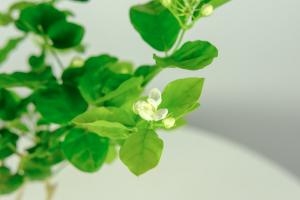Fleshy black rotten roots, apply some erythromycin ointment
Speaking of flowers that are prone to black rot, if Huahua says it is the first in the multi meat row, there must be no other flowers that dare to rank second! After you find that the meat in your home is black and rotten, you must wipe some erythromycin ointment for sterilization and disinfection in time, so that the meat can be saved easily

How can erythromycin ointment wipe some meat
1. When you find that the fleshy black rotten roots in your home, you should remove the fleshy from the basin in time and clean up the soil on the roots as much as possible
2. Before dealing with fleshy black rot, all the leaves with black rot water phenomenon should be removed, so as to avoid the further expansion of black rot
3. Find a sterilized knife and cut off all the black rotten parts on the fleshy rhizome. Remember to cut off all the black rotten parts until the white tender rhizome is exposed, and then put it in a cool and ventilated place to dry the wound
4. Erythromycin ointment has the function of sterilization and disinfection. Smearing meat can effectively avoid bacterial infection and promote the healing of meat wounds. Apply erythromycin ointment to the fleshy wound and put it in a ventilated place to dry for a while
5. Re pot the meat. A layer of ceramsite can be paved on the bottom of the basin to ensure that the basin soil is loose and breathable, and slow-release fertilizer can also be mixed with the basin soil. After that, put the meat in a ventilated place for about 1 week, and then transfer it to nanyangtai
Fortune tree rotten roots, soak some carbendazim
In winter, the rich tree must not be watered too much, because the root system of the rich tree is relatively shallow, the temperature is low in winter, and the water evaporation is very slow. Accidentally, the whole root system is rotten

How can carbendazim be used for fortune tree
1. After the rotten roots of the fortune tree are found, it is necessary to remove the pots of the fortune tree in time, dig out the roots, and then cut off all the rotten roots with a sterilized knife
2. Prepare carbendazim to sterilize and disinfect the root system. In order to make the effect better, carbendazim, root rot spirit and rooting powder can also be mixed for use, which can not only sterilize and disinfect, but also promote the root system of fortune tree to grow as soon as possible
3. Soak the root system of fortune tree in carbendazim solution for at least 1 hour, so as to achieve the purpose of sterilization and disinfection, and then put it in a cool and ventilated place to dry the wound
4. Just put the rich tree in the basin again. For the soil for changing pots of fortune trees, we must choose the loose and breathable nutrient soil, which can be mixed with peat soil and perlite in the ratio of 2:1. We must water less in winter to ensure that the rich tree does not rot
Green pineapple rotten root, wipe some daknin
Dakning's method of preventing and controlling rotten roots was told by a flower friend. At first, Huahua didn't believe it until he tried it himself

How can daknin be used for lvluo
1. In winter, green pineapple often has problems. Whether it is the low temperature at home that frostbite the root system, or the root system rot caused by too much watering, you should first choose to take off the pot and clean up the soil on the root system
2. Find a sterilized knife and cut off the rotten roots, weak roots and fine roots on the roots of green pineapple
3. Dakenin is an antifungal drug that can inhibit fungal reproduction and avoid bacterial infection. Apply a thick layer of daconine to the roots of green pineapple, and then put it in a cool place to dry the wound
4. Prepare loose and breathable soil, such as peat soil and coconut bran, and put the green pineapple into the basin again. Put it in a cool place for a week after putting it in the basin, and then transfer it to a place with good indoor light scattering. Pay attention to indoor ventilation. Watering should be carried out at noon as far as possible
The rotten roots of Clivia, soak in potassium permanganate
Speaking of flowers that are easy to rot, Huahua thinks Clivia is also on the list. After all, the fleshy roots of Clivia are sensitive to water. If you don't pay attention to them a little, they may rot and die

How can potassium permanganate be used for Clivia
1. Once the root of Clivia is rotten, all kinds of yellow leaves will wilt. At this time, it is necessary to remove the basin of Clivia and pull all the soil on the root
2. Prune the roots of Clivia, cut off all the rotten roots, and cut off the old roots and weak roots at the same time
3. Prepare potassium permanganate solution, soak the pruned Clivia root in potassium permanganate solution for more than 20 minutes, and then take it out and dry the wound in a cool and ventilated place
4. In order to ensure looseness and ventilation, you can pad some broken tiles on the bottom of the Clivia basin, and then put nutrient soil. You can even sprinkle a handful of fried melon seeds or peanuts in the basin, and then put the Clivia on the basin again
Huahua will introduce these today
Have all flower friends learned
If there are rotten flowers at home
Let's try it according to Huahua's method

 jackfruit
jackfruit snake plant
snake plant hibiscus
hibiscus hydrangea
hydrangea lavender
lavender Green roses climb al...
Green roses climb al... If you don't pay att...
If you don't pay att... Management of four g...
Management of four g...


































